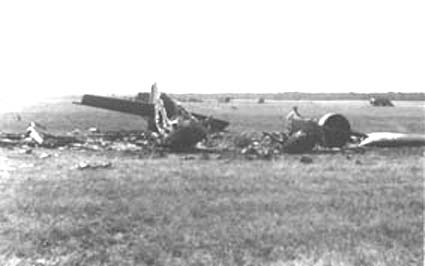
Soviet Aircraft Losses
in World War II


The sad remnants of a shot
down SB bomber in 1941.
At least 1,200, perhaps more than 2,000 Soviet aircraft were destroyed by the Luftwaffe during the first day of the war between Germany and the USSR, June 22, 1941. The official Soviet loss summary gives the figure 106, 400 aircraft losses between 1941 and 1945, including 46,100 combat losses. (Krivosheyev, Grif sekretnosti sniat, 1993.) The Germans claimed the destruction of 77,000 Soviet aircraft (including 45,000 in aerial combat) during the entire war. It is in any case clear that the Soviet Air Forces suffered very high losses during World War II. The high losses suffered by the Soviet Air Force in WW II must be seen in the light of the Stalinist purges. Returning from service in the Spanish Civil War, many Soviet pilots were framed and arrested. Most were executed by firing squad. Yakov Smushkevich, who had been awarded as a Hero of the Soviet Union twice, spent nearly two years in prison. Then, as the invading Germans came closer to Moscow in October 1941, he was executed on the rationale that he might be freed by the Germans.
Pavel Rychagov, an ace who achieved 15 victories in Spain (i.e. more than the German top ace Werner Mölders), was arrested and eventually executed following a critical speech on the state of the Soviet Air Force.
Organized by Leon Trotsky, the new Red Army probably was the most progressive armed forces in the world. For instance, modern paratroopers are in fact a Red Army invention; the German "Green Devils" were set up from a Soviet model, and the British, Americans and others followed duly.
But things changed during Joseph Stalin's autocratical rule. In the political campaign against Trotsky, the much able commander of the Red Air Force (VVS), A. P. Rozengolts, was removed from command in December 1924. Until 1941, four VVS Heads fell victims to Stalin's political repression.
Many VVS unit commanders and - only in the years 1937-39 - were 5,616 aviators dismissed from the VVS out of political reasons. "Many of the new commanders were young and inexperienced and in mid-1941 over 91 percent of all commanders of larger VVS units had held their posts less than six months. "(Lennart Andersson, "Soviet Aircraft 1918-1941".) Against this background, the recovery of the Soviet Air Force - in spite of the leaders in the Kremlin - following the bitter losses in 1941-42, must be regarded as highly remarkable.